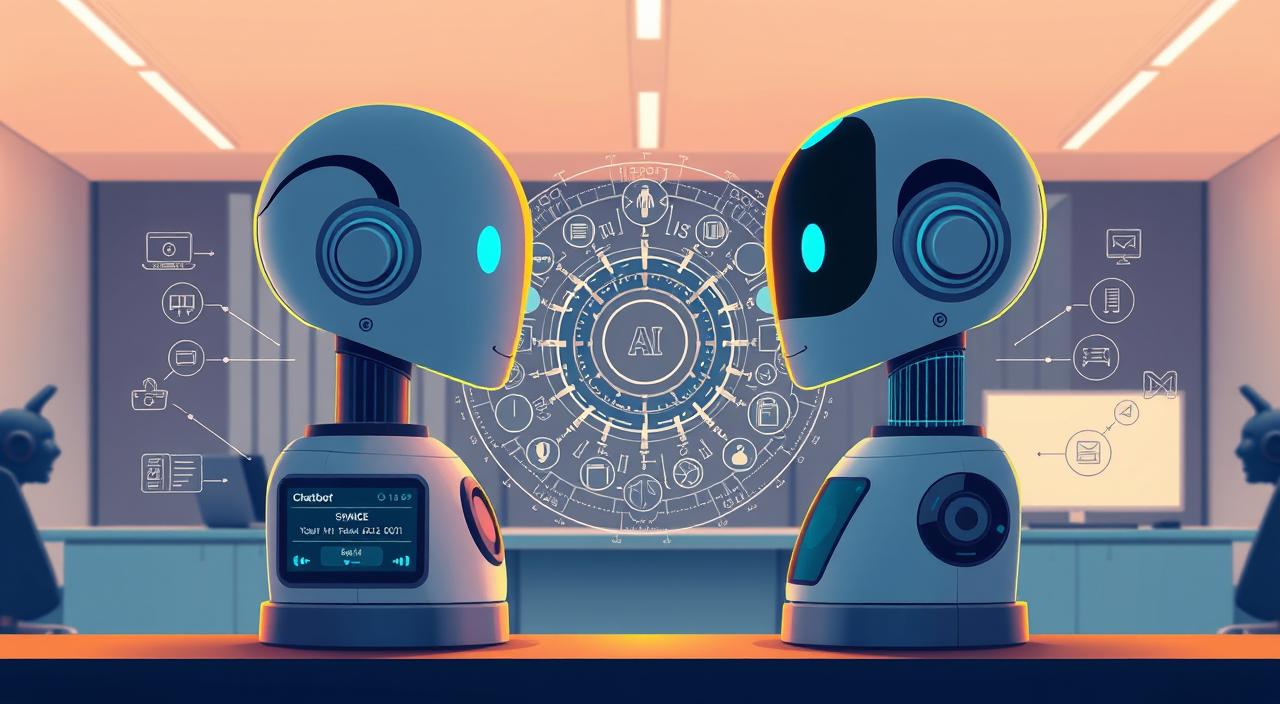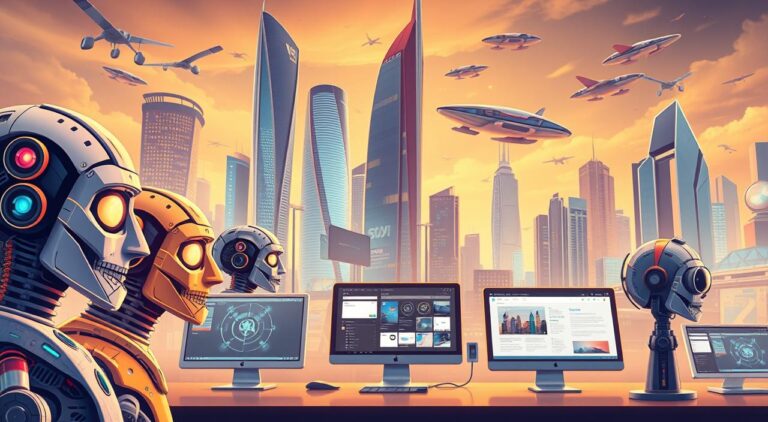Chatbot vs Virtual Assistant AI Tools US: Key Differences Explained
Many businesses use automated support systems to improve their operations. These systems help handle customer questions and internal tasks. They come in different forms with unique strengths.
One type focuses on simple, repeated jobs. It answers common questions quickly. This saves time for both companies and clients.
Another type offers more advanced help. It can understand complex requests. This system often learns from past interactions to provide better service.
Research from Harvard Business School shows these tools boost performance. Teams using them work 40% more efficiently. Picking the right option matters for success.
This article explores how these solutions differ. We will look at their features, best uses, and how to choose what fits your needs.
Key Takeaways
- Automated systems vary in complexity and function.
- Simple tools handle routine tasks effectively.
- Advanced options manage more complicated support needs.
- Proper tool selection enhances team performance.
- Understanding differences leads to better customer experiences.
- Each solution offers unique benefits for operational efficiency.
- Informed choices support long-term business growth.
Understanding Chatbot and Virtual Assistant AI Tools
Two distinct types of automated helpers serve different purposes in today’s workplaces. Each offers unique benefits for handling conversations and completing jobs.
These solutions range from simple question-answering programs to sophisticated digital teammates. Understanding their capabilities helps businesses choose the right fit.
What is a Conversational AI Chatbot?
This technology uses natural language processing to mimic human dialogue. It excels at handling repetitive customer service tasks and frequently asked questions.
Many e-commerce sites use these systems for instant support. HR departments also implement them for basic employee inquiries.
Key characteristics include:
- Task-specific focus on limited functions
- Rule-based responses to predetermined queries
- Website integration for customer interactions
- High-volume handling of simple requests
These conversational AI chatbot features provide 24/7 support without human intervention. Companies like Salesforce incorporate them for efficient client communication.
What is an AI Virtual Assistant?
These advanced systems act as digital teammates rather than simple responders. They use natural language understanding and machine learning to adapt to user needs.
Popular examples include Siri for personal tasks and Alexa for home management. In business contexts, Slack AI helps teams coordinate complex projects.
These assistants offer broader AI virtual assistant capabilities:
- Multifunctional support across various platforms
- Adaptive learning from past interactions
- Proactive assistance with scheduling and data analysis
- Device and application connectivity for personalized help
Research shows businesses using these tools save up to 30% on administrative costs. The right choice depends entirely on your specific operational needs and goals.
Core Technologies Powering Modern AI Tools
The foundation of modern automated helpers lies in cutting-edge computational technologies that process and understand human communication. These systems transform basic queries into meaningful responses through sophisticated algorithms.
Understanding these core technologies helps businesses appreciate how different systems operate. It also clarifies why some solutions handle complex tasks better than others.
The Role of NLP and NLU
Natural language processing forms the backbone of basic automated systems. This technology enables programs to analyze and generate human language patterns.
NLP focuses on converting text into structured data that machines can process. It handles grammar, syntax, and basic meaning extraction effectively.
Natural language understanding goes beyond basic processing. NLU interprets user intent and contextual nuances in conversations.
This advanced capability allows systems to understand what users really mean. It enables more human-like interactions and personalized responses.
- NLP capabilities: Handles straightforward FAQ responses and basic customer service queries
- NLU advantages: Interprets complex requests and adapts to conversational context
- Technology difference: NLP processes language, while NLU comprehends meaning and intent
Google Assistant uses NLU to understand follow-up questions and context shifts. This creates more natural dialogue flows compared to basic systems.
Machine Learning and Adaptive Intelligence
Machine learning provides the ability for systems to improve over time. These algorithms analyze patterns in data to enhance performance.
This technology enables automated helpers to learn from each interaction. They gradually improve accuracy and response quality.
Adaptive intelligence takes machine learning further by personalizing experiences. Systems evolve based on individual user behavior and preferences.
Amazon Alexa demonstrates this by learning user routines and preferences. It adapts notification timing and response styles accordingly.
Advanced technologies like Retrieval-Augmented Generation enhance data handling. RAG combines large language models with enterprise information systems.
Model Context Protocol provides another layer of sophistication. MCP grounds responses in specific organizational data and processes.
K2view’s GenAI Data Fusion platform uses these technologies for accurate enterprise responses. This reduces errors and accelerates information retrieval.
These technological advancements significantly impact operational efficiency. Businesses experience faster response times and more accurate information delivery.
Key Features of Conversational AI Chatbots
Digital dialogue systems excel through specific functionalities that enhance operational workflows and client satisfaction. These platforms handle routine inquiries while maintaining consistent quality across various channels.
Businesses leverage these solutions to manage high-volume interactions efficiently. The right implementation drives significant cost savings while improving customer experiences.
Automation and Task Management
These systems automate repetitive processes with precision. They handle common requests like password resets and billing updates without human intervention.
Context management allows these platforms to remember previous conversations. This prevents customers from repeating information across different sessions.
- Multilingual capabilities serve diverse customer bases effectively, making support accessible to various language speakers
- Sentiment analysis detects user emotions and adjusts responses accordingly, escalating issues when frustration levels rise
- System integrations connect with CRM platforms and HR systems, providing real-time data access for accurate responses
E-commerce platforms use these features for inventory management and order tracking. This automation significantly reduces manual workload while improving accuracy.
Omnichannel Support and Integration
Consistent customer experience across multiple platforms defines modern support excellence. These systems maintain uniform responses whether customers contact through social media, mobile apps, or help desks.
Salesforce implementations demonstrate how seamless integration works across channels. Customers receive the same quality support regardless of their entry point.
The scalability of these solutions makes them ideal for growing businesses. They handle traffic spikes during promotions or peak seasons without additional resources.
“Companies using integrated conversation platforms report 40% faster resolution times and 25% higher customer satisfaction scores.”
These features combine to create efficient, cost-effective support systems. They deliver exceptional value while maintaining operational consistency across all customer touchpoints.
Key Features of AI Virtual Assistants
Advanced digital helpers transform how companies operate by anticipating needs and handling sophisticated jobs. These systems go beyond simple question-answering to become proactive partners in daily workflows.

Proactive Assistance and Personalization
These intelligent systems learn individual preferences through continuous interaction. They notice patterns like preferred communication methods or scheduling habits.
Google Assistant demonstrates this by adapting alert styles based on user behavior. It might switch from email notifications to calendar alerts if that’s what users prefer.
Personalization extends to communication tone and timing. The system adjusts responses to match individual working styles and preferences.
- Learning user habits over time for tailored support
- Adapting notification methods based on observed preferences
- Adjusting communication style to individual user needs
- Anticipating requirements before explicit requests
This personalized approach significantly enhances user satisfaction. People feel understood and supported rather than just processed.
Complex Task Execution and Management
These digital partners handle multi-step processes that would overwhelm simpler systems. They can analyze data, generate reports, and manage complex workflows autonomously.
Slack’s intelligent features show this capability in action. The platform can summarize meetings, highlight action items, and even suggest follow-up tasks.
Complex task automation includes data analysis and insight generation. The system can identify trends and patterns that might escape human notice.
“Teams using advanced digital helpers report 35% faster project completion and 40% better resource allocation.”
These capabilities make modern digital helpers indispensable for growth-focused organizations. They handle sophisticated processes while learning and improving continuously.
The right implementation drives innovation and competitive advantage. Companies gain a powerful partner in achieving strategic business objectives.
Chatbot vs Virtual Assistant AI Tools US: A Direct Comparison
Organizations seeking to implement automated support must recognize the significant variations in capability and approach among available solutions. These differences impact everything from daily operations to long-term strategic planning.
Understanding these distinctions helps businesses select the right technology for their specific needs. The choice often comes down to interaction complexity and learning capabilities.
Interaction Complexity and Scope
Basic automated systems excel at handling straightforward, high-volume queries. They manage account details and frequently asked questions with consistent efficiency.
More advanced solutions tackle nuanced, context-aware conversations. They handle topic changes and multi-step processes that require deeper understanding.
- Scope differences: Basic systems operate within specific domains like customer service, while advanced tools work across applications from scheduling to data analysis
- Response quality: Simple queries receive immediate answers, but complex requests get comprehensive, thoughtful responses
- Application range: Domain-specific focus versus cross-platform functionality creates distinct operational boundaries
HR departments often use basic systems for onboarding questions. Sales teams leverage advanced tools for coaching and strategy development.
Adaptability and Learning Capabilities
Basic automated helpers learn incrementally within their predefined tasks. They recognize common customer issue phrases and improve response accuracy over time.
Sophisticated systems use machine learning to evolve proactively. They suggest workflow optimizations and scale with business growth naturally.
“Research shows basic systems reduce operational costs by 25%, while advanced tools drive revenue growth through intelligent insights in American companies.”
- Learning approach: Task-specific improvement versus organizational-wide adaptation
- Evolution paceGradual refinement within limits versus continuous expansion of capabilities
- Strategic impact: Operational efficiency versus innovation and scalability benefits
Both technologies serve important roles in modern business environments. The right choice depends on specific organizational needs and strategic objectives.
Analyzing Industry Use Cases and Applications
Real-world applications demonstrate how automated helpers transform operations. Different sectors achieve remarkable results by matching technology to specific needs.
Understanding these practical implementations helps businesses make informed choices. The right application drives significant operational improvements.
Optimal Use Cases for Automated Conversation Systems
These systems excel in handling repetitive interactions at scale. They provide immediate responses to common inquiries across various industries.
Retail businesses use them for product information and order tracking. Customers get instant answers about availability and shipping details.
Key applications include:
- Customer service automation for FAQ resolution and incident response
- Workforce coordination in HR departments for onboarding and policy questions
- Case management systems that prioritize and route support tickets efficiently
- Real-time inventory updates for grocery and supply chain providers
Advertising agencies deploy Slack integrations for task allocation. This ensures team members receive assignments promptly.
Early adopters report significant cost reductions in support operations. These systems handle high volume without additional staffing.
Optimal Use Cases for Advanced Digital Assistants
Sophisticated systems manage complex processes and strategic functions. They excel in roles requiring adaptation and deep integration.
Sales teams leverage CRM integrations for lead tracking and management. These tools provide real-time insights into customer pipelines.
Project management benefits from automated data analysis. Systems identify bottlenecks and suggest optimizations automatically.
Notable applications include:
- Sales automation with personalized customer engagement strategies
- Project coordination with predictive timeline adjustments
- Customer success management through equipment availability monitoring
- Healthcare scheduling and medical data retrieval systems
Slack’s Agentforce platform helps construction services manage autonomous operations. Salesforce’s research shows growing adoption in customer-facing roles.
“Companies using these advanced tools report 35% faster project completion and 40% better resource allocation according to industry studies.”
These implementations drive revenue growth through intelligent insights. They enhance decision-making and operational efficiency across organizations.
Businesses must evaluate their specific needs to choose the right solution. Proper alignment ensures maximum return on investment in competitive markets.
How to Choose the Right AI Tool for Your US Business
Selecting the perfect automated solution requires careful evaluation of your operational landscape. The decision impacts everything from daily workflows to long-term growth potential.
American companies face unique challenges when implementing these technologies. Diverse customer bases and regulatory environments demand thoughtful consideration.
Your choice should balance immediate needs with future expansion plans. The right fit enhances both team performance and client satisfaction.
Evaluating Your Business Needs and Goals
Start by analyzing your current operational pain points. Identify areas where automation could deliver the most significant impact.
Consider your long-term vision for growth and innovation. Scalable solutions like Slack’s platform support evolving requirements effectively.
Key evaluation factors include:
- Task complexity: Simple queries need basic systems, while complex workflows require advanced capabilities
- Automation levels: Determine how much human intervention you want to maintain
- Budget constraints: Basic systems offer cost savings, while advanced tools require higher investment
- Customer engagement needs: Multilingual support might be essential for diverse American audiences
Pilot testing provides valuable insights before full deployment. This approach minimizes risk while maximizing effectiveness.
Considering Integration and Scalability
Seamless connection with existing platforms ensures smooth operations. Your new solution should work harmoniously with current CRM and management systems.
Integration capabilities determine how well data flows across your organization. Platforms like Slack’s work OS centralize information access beautifully.
Scalability matters for growing enterprises. Basic systems handle high traffic cost-effectively during expansion phases.
“Companies that prioritize integration report 30% higher operational efficiency and 25% better customer satisfaction scores.”
Advanced solutions adapt to evolving business demands naturally. They learn and grow alongside your organization’s needs.
Consulting professionals ensures you make informed decisions. Their expertise helps align technology choices with strategic objectives.
Ultimately, the best approach often combines both simple and sophisticated tools. This balanced strategy delivers optimal efficiency and innovation.
The Future of AI Conversational Tools in Business
Tomorrow’s business landscape will be shaped by intelligent conversation systems that anticipate needs before they arise. These platforms are evolving beyond simple question-answering into strategic partners that drive growth and innovation.

Emerging technologies are pushing the boundaries of what automated systems can achieve. Companies that embrace these advancements gain significant competitive advantages in dynamic markets.
Trends in Automation and Intelligent Assistance
Autonomous agents represent the next evolution in business technology. These systems handle complex multi-step processes without human intervention.
Generative AI creates more natural and human-like interactions. This technology understands context and maintains coherent conversations across multiple topics.
Multi-modal interfaces combine voice, text, and gesture recognition. This creates intuitive user experiences that feel natural and effortless.
- Rise of self-operating systems for complete task execution
- Advanced generative models for contextual understanding
- Integrated voice and gesture controls for seamless interaction
- No-code platforms like Yellow.ai making technology accessible
- Multilingual support breaking down communication barriers
Real-time data processing enables instant insights and decisions. Systems analyze information as it arrives, providing immediate value.
The Impact on Customer Experience and Operational Efficiency
Continuous support availability transforms customer relationships. Businesses can maintain engagement across time zones and schedules.
Personalized interactions build stronger connections and loyalty. Systems remember preferences and adapt to individual communication styles.
“Early adopters report 40% faster resolution times and 35% higher satisfaction rates among their customer base.”
Automation significantly reduces manual workload and associated costs. Companies redirect human resources to more strategic initiatives.
Operational efficiency improves through streamlined processes and reduced errors. Automated systems maintain consistency and accuracy at scale.
- 24/7 availability ensuring constant customer support
- Personalized experiences driving retention and loyalty
- Cost reduction through automated routine tasks
- Revenue growth from improved customer experiences
- Predictive analytics enabling proactive business decisions
These advancements particularly benefit sectors like healthcare and finance. These industries require both precision and personalization in customer interactions.
Staying competitive requires embracing these technological shifts. Forward-thinking businesses leverage automated systems for both external facing and internal operations.
The future promises continued redefinition of business landscapes through intelligent conversation technology. These tools will drive innovation and efficiency across industries nationwide.
Conclusion
Choosing the right automated support system can transform how your company operates and serves clients. These digital solutions offer distinct advantages for different business needs.
Basic conversation systems excel at handling repetitive tasks and high-volume customer service. More advanced digital helpers provide strategic, adaptive support for complex workflows.
American businesses should evaluate their specific goals and operational requirements. Consider task complexity, integration needs, and scalability when selecting solutions.
Combining both approaches creates a comprehensive strategy. This enhances customer experience while boosting operational efficiency.
Research from Harvard Business School confirms the significant benefits of proper implementation. Explore platforms like Slack or Yellow.ai to find the right fit for your organization’s growth.






